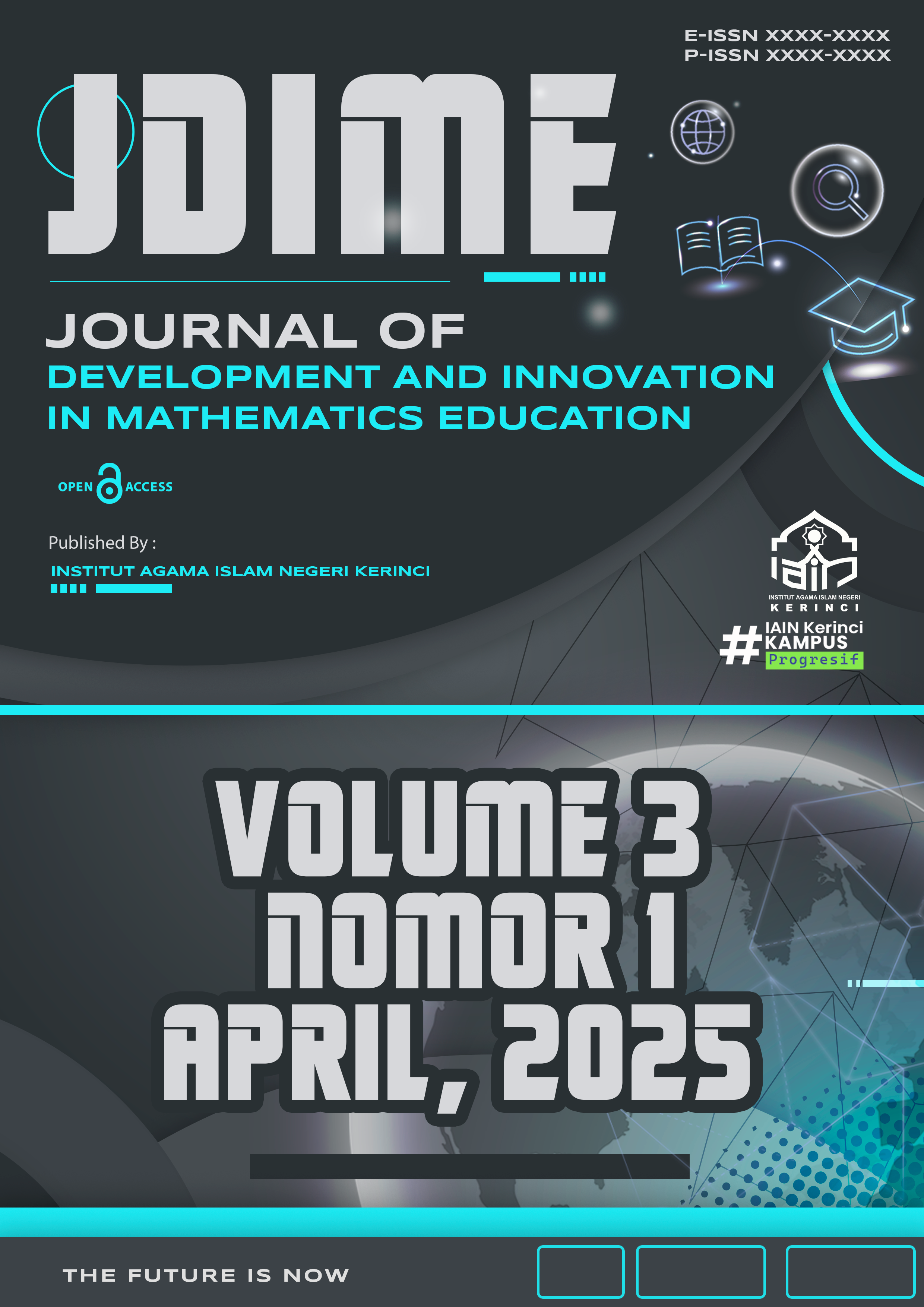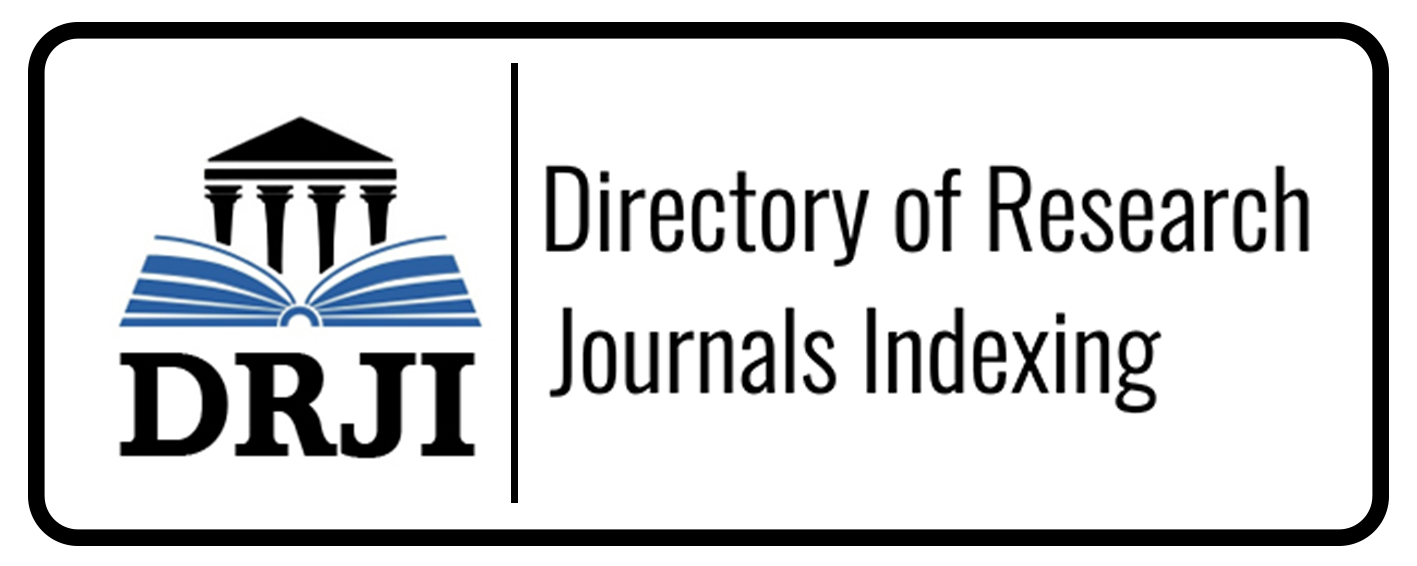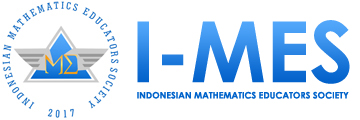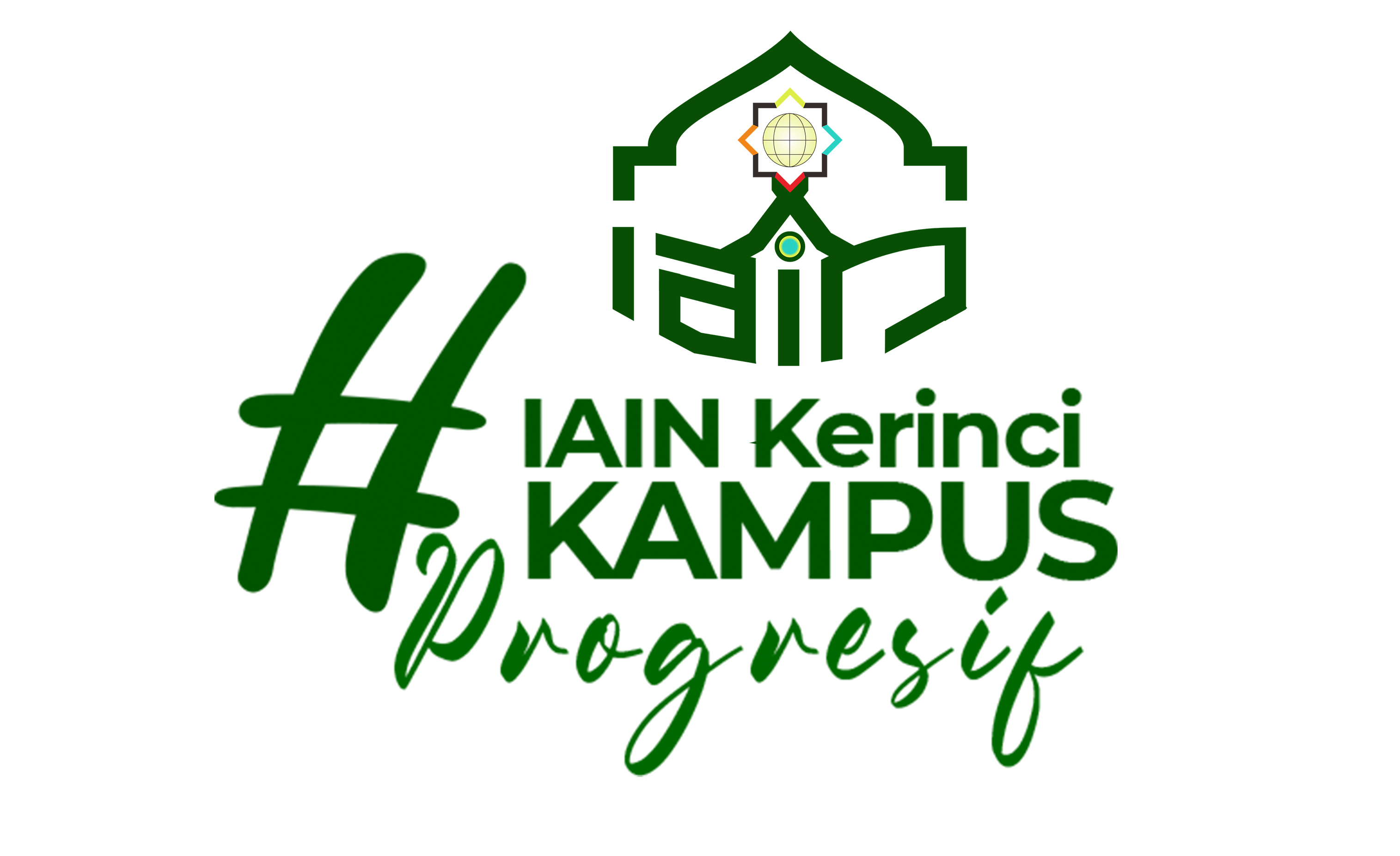Innovative Transformation Geometry Learning: Developing Augmented Reality Media to Boost Students' Critical Thinking
Abstract
This study aims to develop an Augmented Reality (AR)-based transformation geometry learning media to enhance students' understanding and critical thinking skills. The method used is Research and Development (RnD) with a waterfall software development model. This model is chosen due to its systematic and sequential nature, which facilitates the clear mapping of each development stage. The development stages include planning, design, construction, testing, and implementation, involving validity testing by experts and product trials with students. The validity results show that the developed AR application is deemed highly feasible by media and subject matter experts, with validity percentages reaching 82% and 83%, respectively. Product trials with students showed that the AR application is practical to use, with a student learning completion rate of 88.4%. The results of this study indicate that AR-based learning media is effective in improving students' understanding of transformation geometry concepts and enhancing their critical thinking skills. The implication of this research is that AR-based learning media can be integrated into mathematics teaching, particularly for geometry topics, to improve teaching effectiveness and foster the development of better critical thinking skills in students.
Downloads
References
Adams, R. (2015). The role of critical thinking in learning mathematics. Springer.
Akçayir, M., & Akçayir, G. (2017). The use of augmented reality in education: A systematic review. Educational Technology & Society, 20(4), 1-14. https://www.jstor.org/stable/23612785
Alamri, M. (2020). A systematic review of augmented reality applications in education. Computers & Education, 148, 103788. https://doi.org/10.1016/j.compedu.2019.103788
Azuma, R. T. (2017). A survey of augmented reality. Presence: Teleoperators and Virtual Environments, 6(4), 355-385.
Bacca, J., Baldiris, S., Graf, S., Romero, M., Zizzard, F., & Graf, E. (2014). Augmented reality trends in education: A systematic review of research and applications. Educational Technology & Society, 17(4), 133-149. https://www.jstor.org/stable/jeductechsoci.17.4.133
Baki, A., Koyunlu, Ü., & Uğur, G. (2017). The effectiveness of augmented reality for learning geometry. Education and Information Technologies, 22(2), 249-264. https://doi.org/10.1007/s10639-016-9481-0
Berg, E., & Jönsson, A. (2015). The role of visualization in understanding and teaching geometry. Educational Studies in Mathematics, 88(3), 331-347. https://doi.org/10.1007/s10649-015-9629-7
Bower, M. (2019). Design of mobile learning. Springer. https://doi.org/10.1007/978-3-030-02335-5
Bozkurt, A., & Akin, G. (2018). The integration of augmented reality in education: A systematic review. Computers in Education, 127, 66-81. https://doi.org/10.1016/j.compedu.2018.08.007
Brinson, J. R. (2018). The impact of augmented reality on learning outcomes in K-12 and higher education. TechTrends, 62(6), 466-470. https://doi.org/10.1007/s11528-018-0295-5
Cai, M., Zhang, L., & Li, C. (2020). The challenge of implementing augmented reality in education: A case study. Journal of Educational Computing Research, 58(2), 219-238. https://doi.org/10.1177/0735633120922154
Chao, C. M., Liu, F. M., & Chien, H. S. (2020). The application of augmented reality in teaching geometric transformations: A case study. Interactive Learning Environments, 28(7), 925-939. https://doi.org/10.1080/10494820.2019.1575564
Chen, W., & Tsai, C.-C. (2020). Reflections on the integration of augmented reality in education. Educational Technology Research and Development, 68(3), 1201–1218. https://doi.org/10.1007/s11423-020-09717-0
Chin, J. P., & Berge, Z. L. (2020). Exploring critical thinking in mathematics learning. Journal of Educational Technology Systems, 49(1), 25-42. https://doi.org/10.1177/0047239520903687
Clarke, D., & McCallum, R. (2019). Engaging students in geometric transformations with augmented reality. Mathematics Education Research Journal, 31(3), 249-263. https://doi.org/10.1007/s13394-019-00324-0
Cui, Y., & Li, X. (2020). The effectiveness of augmented reality in geometry learning: A meta-analysis. Journal of Educational Psychology, 112(3), 529-546. https://doi.org/10.1037/edu0000357
El-Sheikh, M., & Tashkandi, M. (2020). Augmented reality in the classroom: Improving students' understanding of geometric transformations. Educational Technology Research and Development, 68(1), 73-92. https://doi.org/10.1007/s11423-019-09731-0
Fauzan, I., & Yusuf, Y. (2021). Pengembangan aplikasi pembelajaran geometri menggunakan augmented reality berbasis Android. Jurnal Pendidikan Matematika, 14(1), 45-57.
Ferdiani, R., & Gunawan, A. (2018). Pemanfaatan augmented reality dalam pembelajaran geometri untuk meningkatkan pemahaman konsep siswa. Jurnal Pendidikan dan Pembelajaran, 7(3), 101-113.
FitzGerald, E., Cavanagh, M., & Robinson, L. (2018). Augmented reality in mathematics: A case study of student engagement. Educational Media International, 55(4), 311-322. https://doi.org/10.1080/09523987.2018.1500784
Gholami, S., & Sheybani, M. (2019). The impact of augmented reality on students' critical thinking skills in mathematics education. Educational Technology Research and Development, 67(2), 299-314.
Glover, J., Mdepa, G., & McDougall, A. (2014). Virtual and augmented reality in mathematics learning. Education and Information Technologies, 19(1), 13-31. https://doi.org/10.1007/s10639-012-9246-x
Guralnick, D. M. (2017). Early intervention approaches to enhancing social–emotional development in young children. Journal of Early Intervention, 39(1), 3–16. https://doi.org/10.1177/1053815116680985
Gürbüz, R., & Yıldırım, H. (2016). Augmented reality in the learning process of geometry. Mathematics Education Research Journal, 28(2), 189-201. https://doi.org/10.1007/s13394-016-0192-4
Handayani, S. (2017). Pengajaran geometri berbasis teknologi untuk meningkatkan pemahaman siswa di sekolah menengah. Jurnal Pendidikan Matematika, 10(1), 31-43.
Haryono, T. (2018). Pengaruh penggunaan augmented reality terhadap peningkatan hasil belajar siswa pada materi geometri. Jurnal Teknologi Pendidikan, 5(2), 87-98.
Hasyim, A., & Syafi’i, Z. (2020). The impact of interactive learning on critical thinking skills: The use of AR in mathematics education. Jurnal Pendidikan Matematika, 15(1), 57-70. https://doi.org/10.22342/jpm.15.1.10155
Hendrawan, I., Ramadhan, I., & Prabowo, E. (2021). Augmented reality dalam pendidikan matematika: Pengaruhnya terhadap pemahaman konsep geometri siswa. Jurnal Ilmu Pendidikan, 27(3), 128-136.
Herman, J., Spiteri, M., & Mifsud, L. (2019). Augmented reality in education: A systematic review of research. Educational Research Review, 26, 100-115. https://doi.org/10.1016/j.edurev.2019.02.001
Hidayati, N., & Rahmawati, R. (2018). The influence of augmented reality on the development of critical thinking in mathematics learning. International Journal of Educational Research, 93, 143-155. https://doi.org/10.1016/j.ijer.2018.04.003
Huang, Y.-M., & Chang, C.-K. (2019). The effectiveness of augmented reality on learning outcomes in education: A meta-analysis. Computers & Education, 140, 103602. https://doi.org/10.1016/j.compedu.2019.103602
Hwang, G.-J., Wu, P.-H., & Chen, C.-H. (2017). Smart learning in the 21st century: An overview of the field and future directions. Educational Technology & Society, 20(2), 4–18. https://www.jstor.org/stable/42728988
Jin, M., Lee, J., & Kim, H. (2021). Challenges in integrating augmented reality in the classroom: Case studies from secondary schools. Computers in Education, 175, 104305. https://doi.org/10.1016/j.compedu.2021.104305
Kaufmann, H., & Meyer, B. (2021). Augmented reality in education: A systematic review of research. Computers & Education, 148, 103788. https://doi.org/10.1016/j.compedu.2019.103788
Kynigos, C., & Spyrou, D. (2018). Exploring the use of augmented reality for dynamic geometric visualizations. Journal of Computers in Mathematics and Science Teaching, 37(1), 61-80. https://www.learntechlib.org/p/184567/
Lestari, P., & Suryani, D. (2019). Kesulitan siswa dalam memahami materi geometri transformasi di kelas VIII SMP. Jurnal Pendidikan dan Pengajaran, 8(2), 101-115.
López, S., Vázquez, P., & García, F. (2019). Augmented reality for teaching geometry transformations: A case study in high school classrooms. Journal of Educational Technology Systems, 48(4), 551-571. https://doi.org/10.1177/0047239519865229
Lutfiana, D., Purwanto, P., & Wijayanti, L. (2021). Implementasi teknologi augmented reality dalam pembelajaran geometri untuk meningkatkan hasil belajar siswa. Jurnal Pendidikan Matematika dan Sains, 3(1), 73-85.
Mayer, R. E. (2020). Multimedia learning (3rd ed.). Cambridge University Press. https://doi.org/10.1017/9781108762323
Mohamad, F., Zulkifli, Z., & Fadhilah, N. (2020). Augmented reality-based learning applications for geometry education. International Journal of Emerging Technologies in Learning, 15(8), 14-22.
Muench, F., Kaufmann, H., & Meyer, B. (2018). Augmented reality in education: A systematic review of research. Computers & Education, 148, 103788. https://doi.org/10.1016/j.compedu.2019.103788
Mulyana, S., Sihombing, S., & Ramadhan, S. (2020). Penggunaan augmented reality untuk meningkatkan keterampilan berpikir kritis siswa dalam pembelajaran matematika. Jurnal Teknologi Pendidikan, 10(1), 65-77.
Ng, J. H., Lau, Y. F., & Yee, H. S. (2021). The effectiveness of augmented reality in fostering spatial reasoning and critical thinking in geometry. Interactive Technology and Smart Education, 18(2), 98-113. https://doi.org/10.1108/ITSE-12-2020-0177
Papadopoulos, P. M., Economides, A. A., & Chrysanthou, I. (2019). A study of the effect of augmented reality on students' understanding of geometry concepts. Journal of Educational Computing Research, 58(6), 1361-1379. https://doi.org/10.1177/0735633118822241
Pérez-Marín, D., García, F., & López, S. (2017). The integration of augmented reality in mathematics education: An overview. Research in Mathematics Education, 19(1), 1-16. https://doi.org/10.1080/14794802.2017.1307613
Pramudito, A., & Ariyanto, F. (2020). Penggunaan augmented reality dalam pembelajaran matematika untuk meningkatkan keterlibatan siswa. Jurnal Pendidikan Matematika, 12(1), 123-135.
Prasetyo, Z. K., Hidayat, N., & Saputra, A. (2020). Enhancing critical thinking skills in mathematics through augmented reality-based learning. International Journal of Instruction, 13(2), 441-458. https://doi.org/10.29333/iji.2020.13231a
Radu, I. (2014). Augmented reality in education: A meta-review and cross-media analysis. Personal and Ubiquitous Computing, 18(6), 1533-1546. https://doi.org/10.1007/s00779-013-0711-4
Rahman, A., Wulandari, R., & Sulistyo, T. (2019). Pengaruh pembelajaran berbasis augmented reality terhadap pemahaman geometri siswa. Jurnal Ilmu Pendidikan, 12(2), 211-221.
Sagala, S., & Purnomo, R. (2019). Pengembangan keterampilan berpikir kritis dalam pembelajaran matematika di sekolah menengah. Jurnal Pendidikan Matematika, 6(4), 152-167.
Spiteri, M., & Mifsud, L. (2021). Augmented reality in education: A systematic review of research. Educational Research Review, 26, 100-115. https://doi.org/10.1016/j.edurev.2019.02.001
Sudirman, D., & Firdaus, F. (2020). Pengaruh pembelajaran berbasis teknologi terhadap kemampuan berpikir kritis siswa. Jurnal Pendidikan dan Pembelajaran Matematika, 8(1), 35-46.
Suryani, D., & Pratiwi, N. (2020). Pengembangan media pembelajaran berbasis augmented reality pada materi geometri transformasi. Jurnal Pendidikan Matematika Indonesia, 16(1), 88-99.
Wang, F., Zhang, L., & Liu, Y. (2020). Augmented reality in education: A systematic review of research. Computers & Education, 148, 103788. https://doi.org/10.1016/j.compedu.2019.103788
Wu, H. K., Lee, S. W., Chang, H. Y., & Liang, J. C. (2013). Current status, opportunities and challenges of augmented reality in education. Computers & Education, 62, 41-49. https://doi.org/10.1016/j.compedu.2012.10.024
Wu, P.-H., Hwang, G.-J., & Chen, C.-H. (2020). Smart learning in the 21st century: An overview of the field and future directions. Educational Technology & Society, 20(2), 4–18. https://www.jstor.org/stable/42728988
Yalçınkaya, M., & İbiş, H. (2016). The effectiveness of augmented reality technology in teaching geometric transformations. Educational Media International, 53(4), 253-265. https://doi.org/10.1080/09523987.2016.1252909
Yoon, Y. K., & Jeong, S. R. (2020). Augmented reality-based geometry learning: An application to teaching transformations. Journal of Educational Technology & Society, 23(2), 147-160. https://www.jstor.org/stable/jeductechsoci.23.2.147
Zaki, I., Kader, S., & Putra, M. (2019). The impact of augmented reality on students' critical thinking skills in geometry learning. Mathematics Education Journal, 33(2), 22-34. https://doi.org/10.1080/10642768.2019
Copyright (c) 2025 Konstantinus Denny Pareira Meke, Stefania Baptis Seto, Stefanus Notan Tupen

This work is licensed under a Creative Commons Attribution 4.0 International License.



























 JDIME: Journal of Development and Innovation in Mathematics Education (e-ISSN
JDIME: Journal of Development and Innovation in Mathematics Education (e-ISSN 
